| << Previous -- Index -- Next >> | ||||||
| Chapter 1 | Chapter 2 | Chapter 3 | Chapter 4 | Chapter 5 | Chapter 6 | Chapter 7 |
CHAPTER III
FROM WILDERNESS SUBLIME TO URBAN JUNGLE, 1888 – 1920

Figure 6: Advertising Brochure Depicting Mt. Tom, Holyoke, MA
"Let there be fountains before all the mills, in all the triangles, squares and parks… Have a gigantic fountain at the railroad station, cooling the air and charming the passengers of every passing train. Pump water to your highest hills and let it come back to you with the highest jet of any fountain in the world. If you use that freely which is characteristic of your city and your industry, you lay the best foundation possible for your city beautiful."
- G.A. Parker, Hartford Park Manager, Addressing Holyoke, March 16, 1902[49]
Nature itself became part of Holyoke’s consumer culture in the early 20th century. At the dining room of the city’s Mt. Tom overlook, the walls and ceilings were festooned with ferns and palms (Figure 7). In Steiger’s department store, the “gayest of gala garb vied with Nature in portraying autumn’s gaudy tints of the rarest blending” (Figure 8).[50] For the first time, mass-produced goods and consumer experiences were being displayed in the context of re-created natural features. From the quasi-infinite pastoral vista of Thomas Cole’s Oxbow, to L. Frank Baum’s Wizard of Oz, to the eponymous corn-ucopia of Iowa at the 1915 Panama Pacific Exposition, it became clear that the abundance of nature – if only symbolic – was perceivable in places spanning the continent (Figure 9).[51]
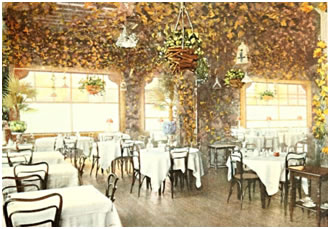
Figure 7: Mt. Tom Summit House - "Garden of the Gods" Dining Room
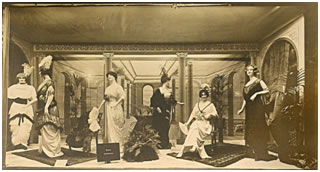
Figure 8: Steiger’s Department Store Display - "During Intermission," 1906
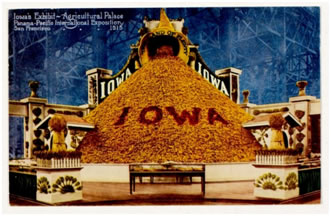
Figure 9: Iowa's Exhibit at the 1915 Panama Pacific Exposition
The 45-foot-high "River of Corn" exhibit at the Panama Pacific Exposition in San Francisco symbolizes the growing faith in abundance beginning in the Progressive Era.
The movement to mold or appropriate the landscape as a Progressive Era reform agenda was due in large part to the earlier influence of Frederick Law Olmsted. Olmsted found appeal in the regenerative effects of unaltered natural features. He called for taste to be cultivated through the power of the scenic and wild. According to Olmsted, workers who lacked opportunity to escape to a park setting would inevitably suffer from paralysis, monomania, melancholy, and malaise.[52] Following the creation of Central Park in 1853, fervor for urban parks spread to hundreds of municipalities. As New York gained its park “for the people,” sightseeing and wilderness excursions also gained in popularity. Places like Niagara Falls, Yellowstone, and the Connecticut River Valley became American variants of the Grand Tour.[53] Initially, these sightseeing excursions were a distinctly high-brow consumer activity – one had to have plenty of disposable income to travel for the simple pleasure of viewing. However, by the 1880s, entrepreneurs saw the potential to sell the spectacle of nature as a product to the middle and lower classes. Such efforts materialized in streetcar parks (such as Lincoln Park in Dartmouth, Massachusetts) and summer vacation destinations (like the bungalow colonies of the Catskills). Holyoke’s extensive streetcar system by the 1880s, as well as the view from a nearby peak – illustrated in Thomas Cole’s Oxbow – made it an ideal target for tourist development.
Planning and Constructing Leisure in Holyoke
In 1888, William S Loomis, one-time owner of the Holyoke Daily Transcript sold his shares in the newspaper to William Dwight and purchased a majority stake in the Holyoke Street Railway Company. At the time, the line was comprised of horse-drawn cars, but Loomis quickly decided to electrify them. Loomis was canny enough to foresee westward suburban development in Holyoke, so he purchased 385 acres on the peak of Mount Tom and touted it as a “wild and picturesque” weekend escape catering to the “best of society.”[54] Mountain Park and Mt Tom introduced Holyokers to the landscape Olmsted extolled, but the views came at a price. For 25 cents in 1912, a spectator could reach the top of Mt Tom by an inclined railway. Instead, most workers chose to spend five cents to reach Mountain Park and stay at the foot of the peak for the simple pleasures of vaudeville, penny arcades, roller coasters, caged bears, and dancing (though the dance hall was touted to be “well policed”).[55] While the leisure time of the city’s workers was spent at places like Mountain Park, members of the city’s park commission had plans to create alternative spaces in the city. Commercial leisure, for many moralists in Holyoke, was the improper way to initiate Holyoke’s working class into the healing properties of Nature. These planners saw in the city itself a great, untapped potential to edify the city’s workers, and they borrowed a term that came into vogue by 1902: “The City Beautiful.”
The City Beautiful movement was born at the 1893 World’s Fair. The Columbian Exposition helped popularize a new vision of the city, one which spread the oft-quoted dictum of the architect Daniel Burnham: “Make no little plans.” Grand, alabaster boulevards in Beaux Arts and Neoclassical design captured the imagination of civic ideologues. Juxtaposed with these massive structures were well-planned pockets of parks and tree-lined streets. City Beautiful shook off the rectilinear grid; instead, business buildings and tenements alike were to be adjacent to diagonal thoroughfares.[56] One of the grandest – and bizarrely utopian – plans of the era was Burnham’s 1905 plan for San Francisco. In the sketches, a monumental cascade proceeded from Twin Peaks to Market Street, a feat that would have been exorbitantly expensive to pump. The plan was shelved after the 1906 earthquake, but it illustrates the architectural braggadocio of the era, a time when an architect could create a Parthenon redux and get away with exhausting the city coffers. As the quote from G.A. Parker at the beginning of this chapter shows, Burnham’s ethos was widespread, and City Beautiful, in its monomaniacal obsession with the city center, diagonal boulevards, and curving, tree-lined residential streets, often disregarded the preferences of a city’s own residents.
What the Holyoke park commissioners likely had in mind when they contacted Frederick Law Olmsted, Jr. in 1901 was the utopian vision offered by people like Burnham and trumpeted by Parker.[57] The commissioners’ allies included moralists writing in the Holyoke Transcript-Telegram who deplored the mechanical contrivances at Mountain Park and – even more – the shooting galleries, billiard rooms, and saloons downtown. An October of 1916 feature in the Transcript quoted Rev. E.B. Robinson of Grace Church (the only Congregational Church in the working class section of the city), who delivered a scathing polemic against gambling. What makes his sermon particularly revealing is that he avoided criticizing the half-dozen established gambling facilities near his church but focused his castigation on the boys shooting craps in the streets and the fundraising schemes by fraternal organizations or churches. “It is allright [sic] to demand that the police close a place in main street if there is one, but they should stop gambling at fairs and circuses as well." The crap shooting, especially, he said was “hostile to the idea of true city life… unsocial... It is an expression of the spirit of one who would live without working. Gambling is divisive, driving people apart.” Despite the Reverend’s characterization of craps as antisocial, in its street form it was a vibrant form of sociability.[58] David Nasaw asserts the children’s community of the streets (craps included) was no atavism, but a way of cooperating in solidarity against the impersonal, rationalized environment in which they lived.[59]
In response to moralist outrage over loafers and kids playing in the street, aldermen and commissioners focused on the city center and its High Street commercial district. Public policy in the era pushed working class leisure and consumption out of its urban core on High Street and into the peripheries of The Flats. Part of this process was heralded under the banner of social reform, which materialized as public bath houses, playgrounds, and crackdowns on street loitering (Figure 10).
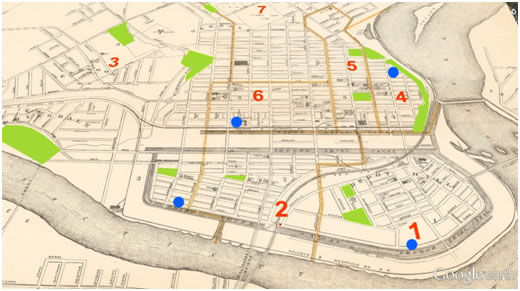
Figure 10: Holyoke Bath Houses
The map above shows the locations of Holyoke's bath houses in 1906 (blue) based on descriptions in the Municipal Register and Sanborn insurance maps of 1911– parks are in green and ward numbers in red. The locations of the bath houses not only suggest the technical needs for water and drainage, but also the desire of park commissioners to appease middle and upper class residents, who found the bath houses to be nuisances that attracted “hoodlums from wards one and four.”[60]
City Beautiful did not drastically alter the physical landscape of the Holyoke, as it had in Washington, D.C. or New York City. If Holyoke had the revenue for such changes, then they would have likely occurred. However, the city – as Constance Green notes – was emerging from a fifteen-year period of graft and overspending. This left it reliant on its factory owners and merchants to provide the impetus for change. Given these circumstances, City Beautiful in Holyoke would emerge as a capitalistic and profit-oriented vision dressed in the costume of social reform. Of course, to a lesser extent, this was also occurring in other places; park commissions across the U.S. were regularly filled by leaders in business and banking.[61]
City Beautiful or City Bountiful?
What becomes clear from the discourse between planners, city officials, and newspaper articles was that city planning was foremost an investment with expected financial payback. Reform Mayor Chester Chapin made the City Beautiful movement an important part of his platform; despite Chapin’s reputation as a frugal penny-pincher with city finances, he was eager for the park commission to lay out a ten-year plan.[62] Chapin’s successor, N.P. Avery was an advocate of a comprehensive City Beautiful plan as well.[63] The motivation for such plans was ambiguous. A close reading of records beginning in the 1901 letter to Olmsted and concluding with Holyoke’s formation of one of the nation’s earliest zoning commissions in 1920 reveals that Olmsted and city leaders were primarily concerned with the economic advantages, rather than social imperatives of these plans.[64] Olmsted, in his 1908 report to the commissioners, noted that outdoor recreation could ensure “sustained high efficiency on the part of our productive workers.” Earlier in the report he mentioned that the development of an adequate trolley system in the city could reduce crowding in the tenement sections, improve the comfort of workers’ home life, and thereby result in “greater efficiency and lower cost of production.” At one point, he even pegged a dollar value on the trees that buttressed residential streets (conservatively, $75 per tree). Knowing his intended audience – that is, business and merchant-dominated park commissioners – Olmsted highlighted the financial benefits of city planning, rather than moral imperatives.[65]
Nevertheless, Olmsted’s report indicates that a good park plan also had the ability to domesticate and control what elites considered to be the deviant behavior of the lower classes, who “not unlike that of some spoiled children of wealthy parents… are apt in the eagerness with which they pursue certain ends either to waste and neglect or recklessly to sell for a pittance other values that they have not yet had time to appreciate.”[66] The parks that Olmsted advised on in Holyoke were touted as places where “we can follow our pursuit of happiness and... where we can play without trespassing on anybody’s grounds; where nobody can complain that we make too much noise, and where we sha’n’t break anything our fathers will have to pay somebody for.”[67] The parks would pay dividends, both in surrounding land value and worker efficiency. At the same time, Olmsted called for surveillance of entry and exit points in order for visitors to be “kept under control” through “strict supervision.” Landscape elements, such as hedges, could be used to screen out the deplorable conditions of nearby tenements and prevent the tendency to cut across the greensward or trespass. Finally, the power of eminent domain could be used to remove nearby billboard advertisements that brought down the value of the land.
While the parks were being redesigned under the direction of Olmsted, the streetcar system in Holyoke was undergoing its own rapid, infrastructural changes. An analysis of the Sanborn fire insurance maps and the 1908 ward map by the city engineer reveal an extensive electrified trolley system in the city, a system that had grown tremendously in the early 1900s and reflected the increased profitability of suburban residential development. The positioning of the lines shows that transportation was eased for suburban neighborhoods, while the industrial communities only benefitted from a single line that coincidentally serviced shopping centers, suburban residential developments, or the streetcar parks of Mountain Park and Mt. Tom (Figure 11).
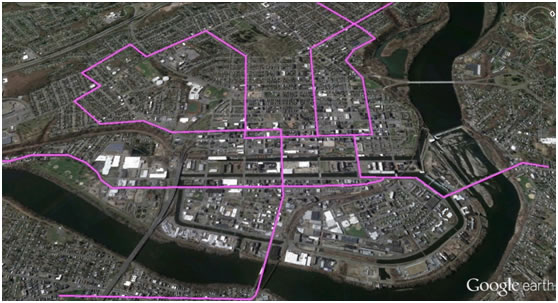
Figure 11: Map of the Holyoke Street Railway System as it Existed in 1911
The Holyoke Street Railway encouraged interactions with consumer-oriented leisure landscapes while workers were largely left without adequate transportation to their workplace. The majority of the factory districts lacked direct transportation, which explains why many workers continued to walk to work, well into the 1920s. Compare this to Figure 10, where bath-houses (non-commercial, publicly provided sites of leisure for the poor) were located farthest from the streetcar lines.
The streetcar system may not have been an explicit attempt to guide passengers to a particular type of consumer landscape (as in Japan); rather, these lines offered a diversity of leisure experiences that disassociated passengers from the industrial and manufacturing environment in the same way that Olmsted considered telephone poles a blight upon the landscape.[68] Anybody who wished to take the streetcars to their place of work was largely out of luck (provided they worked anywhere other than an insurance agency, department store, or pleasure park). This is perhaps why oral histories from Wistariahurst Museum and American International College have a common theme: industrial workers walked to work, despite an extensive transportation network in other areas of the city. Doyle Curran also indicates in Paper City that factory workers overwhelmingly walked to work, despite the streetcar system.[69]
The City Beautiful movement and its descendent, zoning, resulted in a closely regulated and redesigned city landscape that attempted to reorient and domesticate working class recreation and consumption. Most importantly, the movement laid the groundwork to clean out High Street of its working class element and prepare the area for development as consumer destination – with its concomitant hotels, theaters, department stores, and dining establishments. Though playgrounds, bath houses, and parks played an integral role as sites of physical activity and sociability, they were also attempts to control the non-working time of the city’s immigrant residents; as Olmsted wrote, “the time is past when Holyoke can adhere to the ‘village’ policy of leaving children to find their own playgrounds.” “Unprofitable amusement and loafing” would surely follow if the city did not reform its landscape.[70] The parks and playground movement certainly altered the city’s landscape, but the efforts of the park commissioners to remake the leisure practices of workers were only marginally successful. A few years after the apogee of the playground movement, the Valley Arena opened, drawing as many as 4,000 boxing spectators into the working class neighborhood of Tigertown.[71] Similarly, Mountain Park, its own miniature Coney Island, outlasted the high-brow Mt. Tom by five decades.[72]
The two examples above show that workers defined their own leisure spaces, rather than passively accepting the spaces offered by the city’s elite. Still, the pervasive influence of capital on recreational space in Holyoke was an unalterable fact, best illustrated by what seems to be an intentional placement of the city’s bath houses in areas on the fringe of the city, where they would not interrupt the sanitized commerce on High Street (Figure 10). Additionally, moralists used the iron fist of the law to enforce proper consumption practices. Such laws limited the spaces where pawnbrokers, peddlers, and junk dealers could operate; defined the operating hours of billiard halls and shooting galleries; and even prohibited the throwing of snowballs or sledding in the street. To take one example, Chapter 34 of the revised 1912 laws relating to the sale of newspapers stated that paper boys “shall not congregate together, make any unnecessary noise, cry their newspapers in a loud voice, or in any other way disturb or annoy persons… and they shall not cry their newspapers on Sunday.”[73]
Such decisions endeavored to deny the use of common spaces for its immigrant and working class residents, particularly its children. Frederick Engels noticed a similar process in Manchester (which, unlike Holyoke, was an unplanned city). There, Engels recognized a “systematic shutting out of the working-class from the thoroughfares… a concealment of everything which might affront the eye and the nerves of the bourgeoisie.” All while the bourgeoisie made assurances that the working class was “doing famously,” Engels was concerned the ‘Big Wigs’ of Manchester were “not so innocent after all” when it came to their covert shaping of the city landscape.[74] Likewise, Holyoke’s business owners, merchants, developers, and factory owners were either intimately involved or complicit in redesigning the leisure landscape of Holyoke between 1900 and 1940.
How did the working class respond to these developments? And in what ways did the rising culture of mass consumption provide new impetus for immigrants to ‘retreat’ from Main Street and ‘invade’ High Street – despite the patricians’ best efforts to maintain High Street as a defensive bulwark against immigrant invasion. To answer these questions, we will now examine The Delusson Family, a novel that traces the rise of one immigrant household from Main Street to High Street (and concurrently from a life in factories to one marked by mercantile prosperity).
| << Previous -- Index -- Next >> | ||||||
| Chapter 1 | Chapter 2 | Chapter 3 | Chapter 4 | Chapter 5 | Chapter 6 | Chapter 7 |
[49] “To Make Holyoke Beautiful,” Springfield Republican, March 16, 1902, 7.
[50] “The Display at Steiger’s,” Springfield Republican, September 27, 1907, 5.
[51] Cf. Jackson Lears, Fables of Abundance: A Cultural History of Advertising in America (Basic Books, 1995).
[52] Frederick Law Olmsted, “The Yosemite Valley and Mariposa Big Tree Grove,” in America’s National Park System: The Critical Documents (Rowman & Littlefield, 1865), 18.
[53] Ethan Carr, Wilderness by Design: Landscape Architecture and the National Park Service (Lincoln, NE: University of Nebraska Press, 1999), 11–12.
[54] “One of the Builders of Holyoke with a Genius for Organization and a Citizen of Rare Parts,” Holyoke Transcript, July 11, 1914.
[55] L. D. Pellissier, Views On and About Mt. Tom and of Mt. Tom Railroad (Holyoke, Mass., 1912), http://archive.org/details/viewsonaboutmtto00pell, n. pag; “Mountain Park and Mount Tom,” Springfield Republican, June 25, 1905, 13; “Proposed Sale of Mt Tom and Public Control,” Springfield Republican, March 22, 1926, 1.
[56] Cf. Charles Mulford Robinson, Modern Civic Art: Or the City Made Beautiful (G.P. Putnam’s sons, 1904).
[57] Note: Frederick Law Olmsted, Jr. will be referred to as Olmsted for the remainder of this report. Olmsted’s response was perhaps disappointing to Mayor Avery and the alderman, because it suggested – far from grand Burnhamesque visions, practical improvement of city features such as roads, streetcar lines, and landscaping instead of monumental city centers.
[58] For more on the activities of children in the streets, the fascinating 1913 survey by the Peoples’ Institute, a Progressive Era reform organization, conducted a “flashlight” survey in Manhattan’s Hells Kitchen. “Four-hundred civic workers” classified the street activities about “110,000 children.” Cf. John Collier, Edward Morley Barrows. The City Where Crime is Play. People’s Institute, 1914. http://archive.org/details/citywherecrimei00nygoog
[59] David Nasaw, Children of the City: At Work and at Play (Oxford University Press, 1986), 24.
[60] “Bathhouse Question,” Transcript-Telegram, May 6, 1908.
[61] Ian R Stewart, “Politics and the Park: The Fight for Central Park,” in The Physical City : Public Space and the Infrastructure, ed. Neil L Shumsky (New York: Garland Pub., 1996).
[62] “Interest in Park Commissioners’ Report,” Springfield Republican, January 2, 1902, 8.
[63] “Address on the Modern City Beautiful By the Mayor,” Sprinfield Republican, May 8, 1907, 10.
[64] It was not until 1916 that the first formal zoning regulations were enacted in New York. Holyoke’s first zoning commission met in 1920, a year before the Advisory Committee on Zoning was formed under the Hoover administration, and well before most other cities of its size in the U.S. contemplated zoning.
[65] Frederick Law Olmsted, “Draft Report to Mayor N.P. Avery,” Letters, January 10, 1908, 11, 27, 43, Holyoke History Room.
[66] Ibid., 2.
[67] Olmsted, “Draft Report to Mayor N.P. Avery.”
[68] The fascinating history of Japan’s Hankyu Railway, which built its own system of rail stations explicitly designed to service company-owned department stores is a fascinating story that will not be fully described here, but it is worth examining for those interested in early mass consumption environments in Japan. Cf. Leroy W. Demery Jr., “How Japan’s Hankyu Railway Became a Retail Powerhouse,” California Rail News (August 2002): 4–5.
[69] Curran, “Paper City,” 6.
[70] Olmsted, “Draft Report to Mayor N.P. Avery,” 45.
[71] Craig P. Della Penna, Holyoke (Arcadia Publishing, 1997), 48.
[72] As for the bath houses, there is little reference to their fate, though none exist today. In 1923, the Ward 4 bath house – closest to the middle-class neighborhoods was in bad condition and citizens were calling for its complete removal because it “constitute[d] a menace.” Cf. “Park Board Creates Part Time Position.” Springfield Republican, August 8, 1923, 9
[73] The Revised Ordinances of the City of Holyoke, 1913 (M. J. Doyle Printing Company, 1913), 272.
[74] Engels, The Condition of the Working-class in England in 1844, with Preface Written in 1892, Kindle Edition.